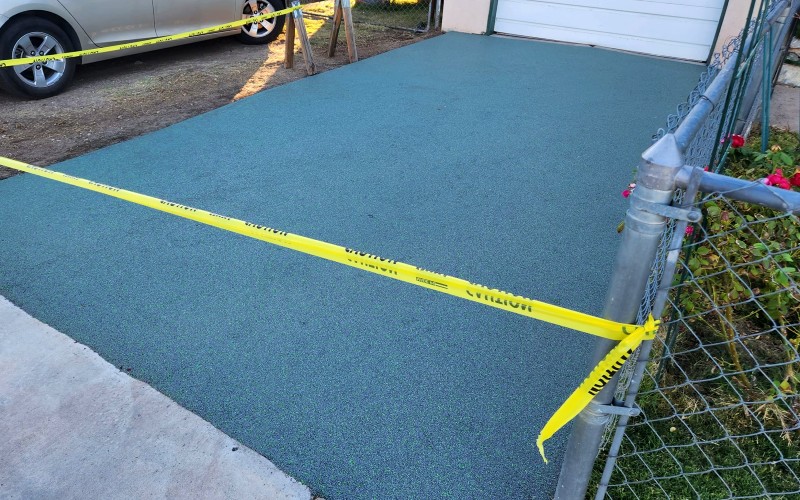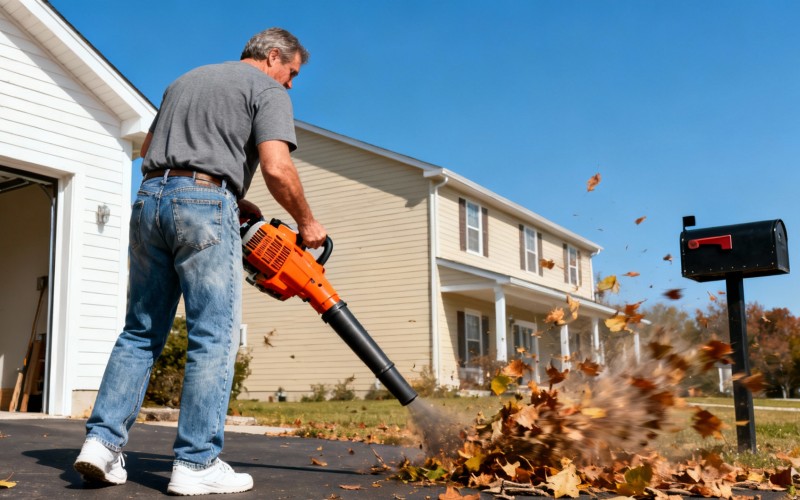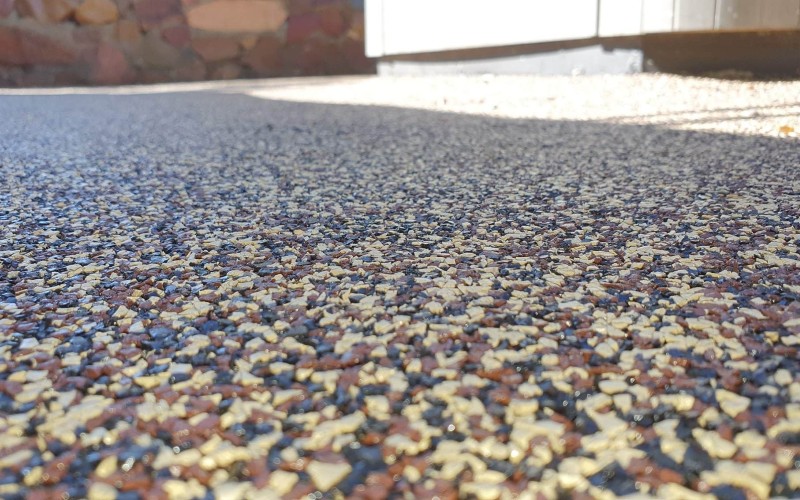Welcome to The Rubber Stone Family
Your Rubber Stone surface is built to last, but proper maintenance ensures it stays beautiful and functional for decades. Unlike traditional concrete or pavers that require constant repairs, rubber surfacing needs minimal upkeep when you follow the right routine. This comprehensive guide will walk you through everything you need to know about maintaining your rubber stone investment in 2025.
Why Maintenance Matters for Rubber Surfaces
Rubber stone surfacing is a significant investment in your property's safety, comfort, and value. Regular maintenance protects this investment by preventing premature wear and easily extending your surface's lifespan to 20+ years.
When you consider the cost breakdown of rubber resurfacing as compared to cheaper surfacing options, investing a little time to upkeep will go a long way.
The EPDM granules that give rubber stone its color and texture maintain their integrity longer when properly cared for. This means the surface will continue to be safer, stronger, and more durable than other options out there.
Beyond aesthetics and safety, proper maintenance preserves the structural integrity of the polyurethane binder. This binder is what makes rubber stone flexible and durable, allowing it to expand and contract with temperature changes without cracking like traditional concrete surfaces.

Understanding Rubber Stone and How it Works
Before diving into maintenance routines, let's understand what makes rubber stone unique.
A poured in place rubberized surface consists of recycled rubber granules, colorful EPDM rubber particles, and a high-performance polyurethane binder. This composition gives rubber stone its distinctive advantages: flexibility, slip resistance, and durability.
The porous nature of rubber stone allows for excellent drainage while maintaining a comfortable walking surface. Unlike sealed concrete or smooth tiles, the textured surface provides natural traction even when wet. This engineered texture is key to the surface's performance, which is why maintenance focuses on preserving rather than altering this characteristic.
If the surface is not cared for, dirt and grime can start to find its ways into the porous surface. This can present a lot of issues over time.
The secret to keeping the surface looking like new is the binder. Over time, the binder on the surface wears away. This can easily be rerolled in an afternoon every 5 years or so.
So as you can see, having a Rubber Stone surface doesn't mean taking on a bunch of new maintenance tasks, you just need to show it some TLC.

Daily and Weekly Care: Simple Steps for Long-Term Results
Quick Daily Maintenance
Daily upkeep is no different than any surface. Remove leaves and debris. This prevents staining and maintains the surface's natural drainage properties. For pool areas, rinse off chlorinated water and sunscreen residue to prevent buildup.
Pet waste should be cleaned immediately to prevent staining and odors. Pay special attention to high-traffic areas like entryways and walkways where dirt and debris tend to accumulate. A quick sweep or rinse takes just minutes but prevents long-term discoloration and wear patterns.
Weekly Upkeep
Sweeping or leaf blowing will keep the surface from getting stained. If you don't have a leaf blower, a soft-bristled broom works best.
For areas with heavy foot traffic or near landscaping, you might need to sweep more frequently during certain seasons. Fall leaf cleanup and spring pollen removal are particularly important for maintaining appearance. The key difference from traditional surfaces? You're not fighting constant maintenance battles like you would with concrete or pavers.
Spot Cleaning as Needed
Address spills and stains as they happen for best results. Most substances can be cleaned with warm water and mild detergent. Oil-based stains from vehicles or cooking should be treated quickly with a degreasing agent to prevent permanent discoloration.

Annual Deep Cleaning - The Key To a Long-Lasting Surface
Pressure Washing Schedule
Here's where rubber stone really shines compared to other surfaces: Plan for pressure washing once or twice per year, depending on your climate and usage.
Spring cleaning removes winter buildup, while fall maintenance prepares your surface for harsh weather in colder climates. Use moderate pressure (1,500-2,000 PSI) to avoid damaging the polyurethane binder.
Start with the lowest effective pressure and increase gradually if needed. Hold the nozzle at least 12 inches from the surface and use a wide spray pattern rather than a concentrated stream. Work in sections, overlapping slightly to ensure even cleaning.
For heavily soiled areas, pre-treat with a mild detergent solution and allow it to sit for 10-15 minutes before pressure washing. This helps break down stubborn dirt and organic matter without requiring excessive pressure.
Seasonal Inspection
During your annual cleaning, inspect for any loose areas or minor damage. Early detection prevents small issues from becoming more expensive. Look for areas where granules might be loosening, signs of wear in high-traffic zones, or any changes in surface texture.
Check drainage patterns to ensure water flows properly off the surface. Poor drainage can lead to standing water, which may cause premature wear or create slip hazards. Clear any blocked drainage areas and ensure proper grading is maintained.
Document any issues with photos and notes, including the date and location. At the first sign of any issues, contact your installer. It is good to catch things early.
If maintenance just isn't your thing - contact your certified rubber surface installer to schedule a maintenance program.

How to Address Common Issues with a Rubber Surface
Stain Removal
Most stains lift easily with mild detergent and water. For stubborn marks like oil or grease, use a degreasing agent and scrub gently with a soft brush. The non-porous nature of rubber stone makes it naturally stain-resistant compared to concrete surfaces, but that doesn't mean you can let things sit.
For organic stains like algae or mildew (common in shaded, moist areas), use a solution of one part white vinegar to three parts water. Apply the solution, let it sit for 15 minutes, then scrub gently and rinse thoroughly. This natural approach works better than harsh chemicals and won't damage your surface.
Rust stains from metal furniture or fixtures can often be removed with a commercial rust remover designed for use on rubber surfaces. Always test cleaning products in an inconspicuous area first to ensure they won't damage or discolor the surface. When in doubt - call your installer.
Minor Repairs and Touch-ups
Small chips or loose granules can be touched up by getting in touch with your installer. Attempting DIY repairs with incorrect materials can void warranties and create larger problems.
Professional repairs typically involve cleaning the affected area, applying primer if needed, and installing matching rubber stone material. The repair area is then sealed and allowed to cure properly.
Weather Damage
Unlike concrete that cracks and crumbles, rubber stone handles freeze-thaw cycles like a champ. Still, clearing snow and ice promptly prevents unnecessary stress on the surface. Try to use plastic shovels rather than metal ones to avoid scratching, and avoid ice-melting chemicals that could affect the polyurethane binder.
Our surfaces have been tested against heavy machinery, snow plows, metal shovels and more...
but it's good to be on the safe side.
In extremely hot climates, consider providing shade over high-use areas during peak summer months. While rubber stone stays cooler than concrete, prolonged exposure to intense UV radiation can gradually fade colors over time.
For coastal areas, rinse salt spray off surfaces regularly to prevent buildup that could affect the binder's integrity over time. The natural porosity of rubber stone helps resist salt damage, but regular rinsing provides additional protection.
Seasonal Maintenance Calendar
Spring Maintenance (March-May)
Comprehensive pressure washing removes winter buildup and prepares your surface for heavy use. Inspect for any damage from freeze-thaw cycles and address issues before they worsen. Clear drainage areas of debris that accumulated over winter.
Apply any necessary touch-up repairs during mild weather when materials cure properly. Check and clean surrounding landscape to prevent organic debris accumulation. Spring is your fresh start for maintaining that like-new appearance all year long.
Summer Maintenance (June-August)
Weekly sweeping or blowing becomes more important in high-pollen areas. Immediate cleanup of pool chemicals, sunscreen, and food spills prevents staining during peak usage months. Monitor high-traffic areas for wear patterns that might need attention.
Ensure adequate drainage during heavy summer storms. The beauty of rubber stone? Even during the busiest season, maintenance remains minimal compared to concrete alternatives.
Fall Maintenance (September-November)
Increase sweeping frequency during leaf-fall season to prevent organic matter buildup. Consider a second annual pressure washing if your area experiences heavy leaf drop or storm debris. Prepare surface for winter weather by ensuring proper drainage and completing any needed repairs.
Trim overhanging branches that drop debris onto your surface. Apply any final repairs before cold weather when curing conditions become less favorable.
Winter Maintenance (December-February)
Prompt snow and ice removal with appropriate tools keeps your surface safe and functional. Monitor for ice dam formation that could affect drainage patterns. Limit use of de-icing chemicals that might interact with the polyurethane binder.
Plan for spring maintenance and any needed repairs during the slower season. Winter proves rubber stone's superiority over materials that crack and deteriorate in harsh conditions.

The Many Benefits of Proper Surface Maintenance
Regular maintenance prevents expensive repairs and extends your surface's lifespan significantly. Compare this to traditional materials: pavers require releveling every few years, while concrete needs regular sealing and crack repair. Rubber stone maintenance costs remain minimal throughout its lifespan.
A well-maintained rubber stone surface can last 20-25 years with minimal intervention. Neglected surfaces might need major repairs or replacement in 10-15 years. The difference in long-term costs can be substantial, making regular maintenance a smart financial decision.
Safety and Performance
Clean, well-maintained surfaces retain their slip-resistant properties and structural integrity. This becomes critical for pool deck applications where wet conditions are common and safety is paramount. Your family's safety depends on proper maintenance of these crucial performance characteristics.
Proper maintenance also preserves the surface's shock-absorbing properties. These characteristics are crucial for Playground applications where fall protection is required by safety standards.
Environmental Benefits
Proper care helps your recycled rubber surface continue reducing landfill waste while providing decades of service. The longevity of well-maintained rubber stone makes it an environmentally responsible choice that keeps tire waste out of landfills for extended periods.
Additionally, the minimal maintenance requirements mean fewer chemical cleaners and less water usage compared to other surface materials. This translates to a smaller environmental footprint throughout your surface's entire lifespan.
Aesthetic Value
Regular maintenance preserves the vibrant colors and attractive appearance that make rubber stone such a popular choice. EPDM granules maintain their color integrity when properly cared for, ensuring your surface continues to enhance your property's curb appeal. First impressions matter, and a well-maintained rubber stone surface creates lasting positive impact.
Wrapping Up
Rubber stone maintenance is refreshingly simple compared to traditional surfaces. With basic daily care, occasional sweeping, and annual pressure washing, your investment will provide decades of safe, comfortable, and attractive service. The minimal maintenance requirements make rubber surfacing an ideal choice for busy homeowners and commercial properties alike.
The key to successful rubber stone maintenance is consistency and using appropriate techniques. By following this comprehensive guide, you'll protect your investment, maintain safety standards, and enjoy the many benefits of rubber surfacing for years to come. Your future self will thank you for the time invested in proper care today.
For more information about rubber stone products and installation, find a dealer in your area by clicking the Get a Quote button below.
